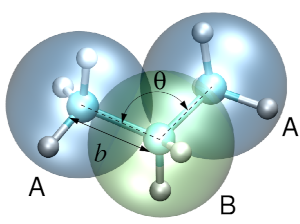Introduction¶
Versatile Object-oriented Toolkit for Coarse-graining Applications, or VOTCA, is a package which helps to systematically coarse-grain various systems [Ruehle:2009.a]. This includes deriving the coarse-grained potentials, assessing their quality, preparing input files required for coarse-grained simulations, and analyzing the latter.
A typical coarse-graining workflow includes sampling of the system of interest, analysis of the trajectory using a specific mapping and a coarse-graining method to derive coarse-grained potentials.

Fig. 1 Three-bead coarse-grained model of propane.¶
The workflow can be exemplified on coarse-graining of a propane liquid. A single molecule of propane contains three carbon and eight hydrogen atoms. A united atom coarse-grained representation of a propane molecule has three beads and two bead types, A and B, with three and two hydrogens combined with the corresponding atom, as shown in the figure above. This representation defines the , as well as the bonded coarse-grained degrees of freedom, such as the bond \(b\) and the bond angle \(\theta\). Apart from the bonded interactions, \(u_b\) and \(u_\theta\), beads belonging to different molecules have non-bonded interactions, \(u_\text{AA}\), \(u_\text{AB}\), \(u_\text{BB}\). The task of coarse-graining is then to derive a potential energy surface \(u\) which is a function of all coarse-grained degrees of freedom. Note that, while the atomistic bond and angle potentials are often chosen to be simple harmonic functions, the coarse-grained potentials cannot be expressed in terms of simple analytic functions. Instead, tabulated functions are normally used.
The coarse-graining method defines criteria according to which the potential energy surface is constructed. For example, for the bond \(b\) and the angle \(\theta\) can be used. In this case a coarse-grained potential will be a potential of mean force. For the non-bonded degrees of freedom, the package provides or methods. In this case the radial distribution functions of the coarse-grained model will match those of the atomistic model. Alternatively, (or multiscale coarse-graining) can be used, in which case the coarse-grained potential will approximate the many-body potential of mean force. The choice of a particular method is system-specific and requires a thorough consistency check. It is important to keep in mind that coarse-graining should be used with understanding and caution, methods should be crossed-checked with each other as well as with respect to the reference system.
The package consists of two parts: a C++ kernel and a scripting engine. The kernel is capable of processing atomistic topologies and trajectories and offers a flexible framework for reading, manipulating and analyzing topologies and generated by MD/SD/MC sampling trajectories. It is modular: new file formats can be integrated without changing the existing code. Currently, an interface for GROMACS [gromacs4] and LAMMPS [lammps] topologies and trajectories is provided. The kernel also includes various coarse-graining tools, for example calculations of probability distributions of bonded and non-bonded interactions, correlation and autocorrelation functions, and updates for the coarse-grained pair potential.
Before using the package, do not forget to initalize the variables in the bash
source <csg-installation>/bin/VOTCARC.bash
More details as well as several examples can be found in ref. [Ruehle:2009.a]. Please cite this paper if you are using the package.